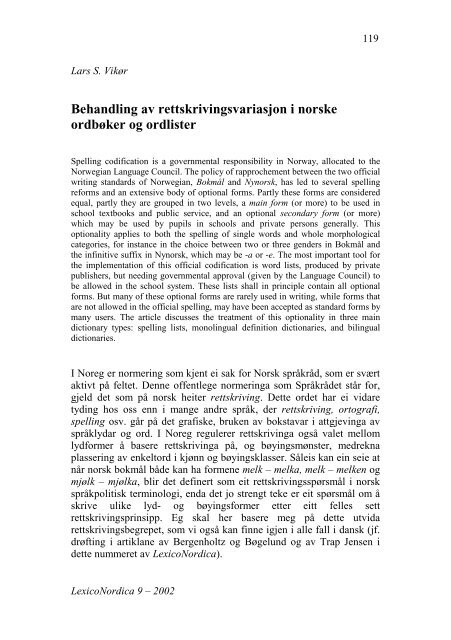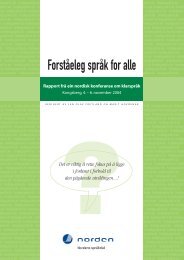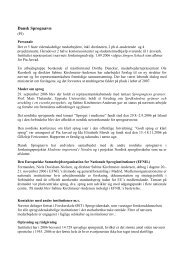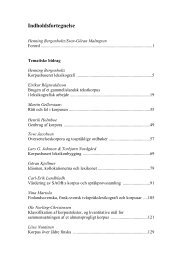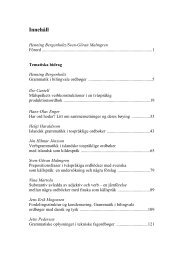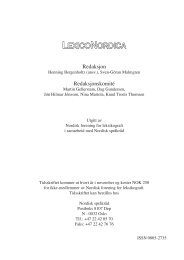- Page 1 and 2:
LEXICONORDICA 9 Tidsskrift om leksi
- Page 3 and 4:
Oddrun Grønvik Er det stygt å sei
- Page 5 and 6:
Henning Bergenholtz & Sven-Göran M
- Page 7 and 8:
2. Hvilke leksikografiske beslutnin
- Page 9 and 10:
Sven-Göran Malmgren Normering i Sv
- Page 11 and 12:
gör det - att Dalin redan hade utf
- Page 13 and 14:
”svåra ord”, men arbetet med m
- Page 15 and 16:
Men denna kunskap blev efterhand al
- Page 17 and 18:
talspråket, där det - bortsett fr
- Page 19 and 20:
särskilt beträffande stavningen a
- Page 21 and 22:
Att man efter hand kommit till insi
- Page 23 and 24:
pläderar visserligen i princip fö
- Page 25 and 26:
SAOL 1-9 = Svenska Akademiens ordli
- Page 27 and 28:
understödd av många språkvetare
- Page 29 and 30:
materialet. Begreppet kan referera
- Page 31 and 32:
Men vi ska börja med några ord om
- Page 33 and 34:
4.2.3 Ordböjning En stor del av de
- Page 35 and 36:
ställen, vilket i fortsättningen
- Page 37 and 38:
Kristina Nikula Användaren, normen
- Page 39 and 40:
tankarna då de tänker på använd
- Page 41 and 42:
Eftersom språket lever är det i o
- Page 43 and 44:
Norm har en annan form och status
- Page 45 and 46:
samma funktion. Man kan till och me
- Page 47 and 48:
det geografiska kriteriet innan det
- Page 49 and 50:
speciell betydelse då det för t.e
- Page 51 and 52:
nödvändiga eller gångbara i huvu
- Page 53 and 54:
Litteratur Allén, Sture 1987. Sven
- Page 55 and 56:
Nikula, Kristina 1991. Är norm ett
- Page 57 and 58:
dåvarande Kejserliga Alexandersuni
- Page 59 and 60:
finlandssvenskan och rikssvenskan p
- Page 61 and 62:
metoder har en positivare syn på f
- Page 63 and 64:
ordet påskannandag för det som i
- Page 65 and 66:
språket, speciellt om man som båd
- Page 67 and 68:
använda programmet gör det för a
- Page 69 and 70:
om bøjning, orddannelse, faste ven
- Page 71 and 72:
forener det normative krav om fasth
- Page 73 and 74:
hododendron sb. - uofficiel, men al
- Page 75 and 76: eautyboks beautybox compactdisk com
- Page 77 and 78: eksempelvis bestemt form singularis
- Page 79 and 80: fx i græsk, udtrykker et ønske, e
- Page 81 and 82: ukorrekt). blindskrift blev opfund
- Page 83 and 84: udtryk fra den mere almensproglige
- Page 85 and 86: Henning Bergenholtz & Christina Bø
- Page 87 and 88: I en lignende situation er Lise usi
- Page 89 and 90: nøjagtigt (NLO 1997, HARTMANN/JAME
- Page 91 and 92: procentangivelser eller markeringer
- Page 93 and 94: kraftvarmeværk 284 85,0% 5495 98,3
- Page 95 and 96: med korrektur af elevers stile vil
- Page 97 and 98: tion, svag præskription og meget s
- Page 99 and 100: ikke svarer til den empiriske basis
- Page 101 and 102: metodik, som leksikografen eksplici
- Page 103 and 104: I Danmark har vi haft et godt udgan
- Page 105 and 106: Hvis man vælger at udarbejde en pr
- Page 107 and 108: variant Google RO 2 modemet, modeme
- Page 109 and 110: (*alle andre belæg med lakket er m
- Page 111 and 112: 105 sisch-deutsche Lexikographie: G
- Page 113 and 114: 107 TRASK 1993 = Trask, R.L.: A Dic
- Page 115 and 116: 108 normens forbillede ønsker at f
- Page 117 and 118: 110 sive den mundtlige variant i ra
- Page 119 and 120: 112 Men på trods af denne massive
- Page 121 and 122: 114 Men uden selvfølgelig at vove
- Page 123 and 124: 116 De ser den snarere som i forlæ
- Page 125: 118 Frangoudaki, Anna 1992: Digloss
- Page 129 and 130: 121 Større endringar vart gjennomf
- Page 131 and 132: 123 valfrie, skal dei stå på kvar
- Page 133 and 134: 125 berre forordet opplyser om den
- Page 135 and 136: 127 tradisjonelle formene i offisie
- Page 137 and 138: 129 alderdommeleg og svært lite br
- Page 139 and 140: Ruth Vatvedt Fjeld Normering i klem
- Page 141 and 142: 133 eller normativt siktemål til s
- Page 143 and 144: 135 være. Ordlistene må derfor by
- Page 145 and 146: 3.1 Enkelhet og mangfold 137 Språk
- Page 147 and 148: 139 nevnte. Det sier at stavekontro
- Page 149 and 150: 141 de vanlige kodene ikke på. I B
- Page 151 and 152: 143 gjennom alle formene og vurdere
- Page 153 and 154: Thus lexicographers are faced with
- Page 155 and 156: 147 litteraturvitenskap ved Univers
- Page 157 and 158: Oddrun Grønvik Er det stygt å sei
- Page 159 and 160: 151 Her vart ei amerikansk ordbok1
- Page 161 and 162: 153 Den største gruppa med nemning
- Page 163 and 164: 5. Kva kategoriar i ordartikkelen k
- Page 165 and 166: 157 Alle ordbøkene har neger (negr
- Page 167 and 168: 159 Det er verd å merkje seg at de
- Page 169 and 170: 161 tida får både ordboksredaktø
- Page 171 and 172: 163 av utfall og private synspunkt
- Page 173 and 174: 165
- Page 175 and 176: 167
- Page 177 and 178:
169
- Page 179 and 180:
171
- Page 181 and 182:
173
- Page 183 and 184:
SAOB neger manlig individ tillhöra
- Page 185 and 186:
WNTCD black 7) a person of dark com
- Page 187 and 188:
SAOB SAME jfr SAME-FOLK(ET). jfr la
- Page 189 and 190:
NOB tater 1 person som høyrer til
- Page 191 and 192:
NOSD Jewess (same entry as above)
- Page 193 and 194:
Sandro Nielsen Overvejelser angåen
- Page 195 and 196:
175 1. Den primære funktion: overs
- Page 197 and 198:
177 behov i størst muligt omfang k
- Page 199 and 200:
179 En anden form for numerusproble
- Page 201 and 202:
1. Ledelsespåtegning 2. Revisionsp
- Page 203 and 204:
183 Herudover skal regnskabsekspert
- Page 205 and 206:
185 Dette skal kun opfattes som et
- Page 207 and 208:
187 alfabetisk ordnet liste over al
- Page 209 and 210:
189 sætninger af omtekstens afsnit
- Page 211 and 212:
9.3 Omvendt søgning (engelsk-dansk
- Page 213 and 214:
[lemma] kreditrisiko [grammatik] (e
- Page 215 and 216:
195 Kirkness, Alan 1989: Wörterbuc
- Page 217 and 218:
196 Sprognævn skal udsende noget,
- Page 219 and 220:
198 potentielle brugere. Endvidere
- Page 221 and 222:
200 i februar-marts 2002. Baggrunde
- Page 223 and 224:
202 Dette er ofte uhyre nyttige opl
- Page 225 and 226:
204 5. I denne forbindelse burde Re
- Page 227 and 228:
206 Andre helt regelmæssige udsagn
- Page 229 and 230:
208 Der kan gives mange andre eksem
- Page 231 and 232:
Ilse Cantell LexicoNordica 9 - 2002
- Page 233 and 234:
211 Den form av slang som Lindfors
- Page 235 and 236:
213 intellektuella till kriminella
- Page 237 and 238:
215 förekomma i ”vanliga” slan
- Page 239 and 240:
Dag Gundersen Engelsk stor ordbok L
- Page 241 and 242:
221 begynnere, og altså også yngr
- Page 243 and 244:
223 derfor fårikål, mens lapskaus
- Page 245 and 246:
225 og for de fleste fremdeles gjø
- Page 247 and 248:
227 ikke å høre til den. F.eks.:
- Page 249 and 250:
Pirkko Kuutti Första ordboken Lexi
- Page 251 and 252:
231 Det förklaras att tärningarna
- Page 253 and 254:
233 paitsio heter offside på engel
- Page 255 and 256:
235 exempel i båda betydelsegruppe
- Page 257 and 258:
237 genomsnitt finns det en illustr
- Page 259 and 260:
239 En del av illustrationerna finn
- Page 261 and 262:
241 ett lämpligt urval uppslagsord
- Page 263 and 264:
242 samma inbördes förhållande t
- Page 265 and 266:
244 om engelskan inom detta område
- Page 267 and 268:
246 att avgöra om naturae står i
- Page 269 and 270:
248 skulle det bli identiskt med tu
- Page 271 and 272:
250 den svenska förleden räddning
- Page 273 and 274:
252 är lättanvänd och överskåd
- Page 275 and 276:
Nina Martola Två nya lättillgäng
- Page 277 and 278:
FIGUR 1. Ur Norstedts första svens
- Page 279 and 280:
257 Cirkeldefinitionerna är i och
- Page 281 and 282:
259 mynna ut - Saknas. Ordet mynnin
- Page 283 and 284:
FIGUR 2. Ur Natur och Kulturs Svens
- Page 285 and 286:
263 första förklaring ”används
- Page 287 and 288:
265 saknas som uppslagsord och för
- Page 289 and 290:
267 användaren har det svenska sta
- Page 291 and 292:
269 konstruktionen betala någon f
- Page 293 and 294:
271 uppslagsord saknas men sidantal
- Page 295 and 296:
272 Av dessa skäl är min recensio
- Page 297 and 298:
274 process (latinisterna är ju f
- Page 299 and 300:
276 bara Tallinum. Under medeltiden
- Page 301 and 302:
278 visande ur utländsk synvinkel:
- Page 303 and 304:
280 stavelserna i uttalet. Däremot
- Page 305 and 306:
282 och nulatinet. En läsare som i
- Page 307 and 308:
284 Pitkäranta, Reijo & Vilkkonen,
- Page 309 and 310:
286 Som brukligt är inleds idiomor
- Page 311 and 312:
288 form. I det fjärde underkapitl
- Page 313 and 314:
290 Ordboksartiklarna är av varier
- Page 315 and 316:
292 (vulgärt), av vilka ark. på g
- Page 317 and 318:
Litteratur 294 âerny‰eva, I.I. 1
- Page 319 and 320:
296 Han konstaterar också att lexi
- Page 321 and 322:
298 research, 9. Case studies. Kapi
- Page 323 and 324:
Landau 300 Landaus bok är på mån
- Page 325 and 326:
302 Definitionskapitlet är däremo
- Page 327 and 328:
were to dissect the dictionary stru
- Page 329 and 330:
306 Skildringen av de ”lexikograf
- Page 331 and 332:
308 Om bokens inledningskapitel fin
- Page 333 and 334:
310 I det korta avsnittet om ordbok
- Page 335 and 336:
312 Béjoint, H. 1994: Tradition an
- Page 337 and 338:
Hjalmar P. Petersen et al. Donsk-f
- Page 339 and 340:
Inger Hesslin Rider Ordboksredaktö
- Page 341:
Anden litteratur: Haiman, John 1980


